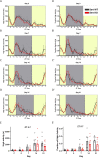Food Anticipatory Activity on Circadian Time Scales Is Not Dependent on Central Serotonin: Evidence From Tryptophan Hydroxylase-2 and Serotonin Transporter Knockout Mice
- PMID: 33041772
- PMCID: PMC7517832
- DOI: 10.3389/fnmol.2020.534238
Food Anticipatory Activity on Circadian Time Scales Is Not Dependent on Central Serotonin: Evidence From Tryptophan Hydroxylase-2 and Serotonin Transporter Knockout Mice
Abstract
A number of studies implicate biogenic amines in regulating circadian rhythms. In particular, dopamine and serotonin influence the entrainment of circadian rhythms to daily food availability. To study circadian entrainment to feeding, food availability is typically restricted to a short period within the light cycle daily. This results in a notable increase in pre-meal activity, termed "food anticipatory activity" (FAA), which typically develops within about 1 week of scheduled feeding. Several studies have implicated serotonin as a negative regulator of FAA: (1) aged rats treated with serotonin 5-HT2 and 3 receptor antagonists showed enhanced FAA, (2) mice lacking for the 2C serotonin receptor demonstrate enhanced FAA, and (3) pharmacologically increased serotonin levels suppressed FAA while decreased serotonin levels enhanced FAA in mice. We sought to confirm and extend these findings using genetic models with impairments in central serotonin production or re-uptake, but were surprised to find that both serotonin transporter (Slc6a4) and tryptophan hydroxylase-2 knockout mice demonstrated a normal behavioral response to timed, calorie restricted feeding. Our data suggest that FAA is largely independent of central serotonin and/or serotonin reuptake and that serotonin may not be a robust negative regulator of FAA.
Keywords: Slc6a4; circadian rhythm; food anticipatory activity; food entrainment; tryptophan hydroxylase-2.
Copyright © 2020 Gallardo, Martin and Steele.
Figures


Similar articles
-
A sex difference in circadian food-anticipatory rhythms in mice: Interaction with dopamine D1 receptor knockout.Behav Neurosci. 2015 Jun;129(3):351-60. doi: 10.1037/bne0000058. Behav Neurosci. 2015. PMID: 26030433
-
Exploring the role of locomotor sensitization in the circadian food entrainment pathway.PLoS One. 2017 Mar 16;12(3):e0174113. doi: 10.1371/journal.pone.0174113. eCollection 2017. PLoS One. 2017. PMID: 28301599 Free PMC article.
-
Type 1 dopamine receptor (D1R)-independent circadian food anticipatory activity in mice.PLoS One. 2021 Feb 8;16(2):e0242897. doi: 10.1371/journal.pone.0242897. eCollection 2021. PLoS One. 2021. PMID: 33556069 Free PMC article.
-
The adjustment and manipulation of biological rhythms by light, nutrition, and abused drugs.Adv Drug Deliv Rev. 2010 Jul 31;62(9-10):918-27. doi: 10.1016/j.addr.2010.06.003. Epub 2010 Jun 23. Adv Drug Deliv Rev. 2010. PMID: 20600408 Review.
-
The Mysterious Food-Entrainable Oscillator: Insights from Mutant and Engineered Mouse Models.J Biol Rhythms. 2018 Oct;33(5):458-474. doi: 10.1177/0748730418789043. Epub 2018 Jul 23. J Biol Rhythms. 2018. PMID: 30033846 Free PMC article. Review.
Cited by
-
Maternal neglect alters reward-anticipatory behavior, social status stability, and reward circuit activation in adult male rats.Front Neurosci. 2023 Jul 14;17:1201345. doi: 10.3389/fnins.2023.1201345. eCollection 2023. Front Neurosci. 2023. PMID: 37521688 Free PMC article.
-
Serotonin, food intake, and obesity.Obes Rev. 2021 Jul;22(7):e13210. doi: 10.1111/obr.13210. Epub 2021 Feb 9. Obes Rev. 2021. PMID: 33559362 Free PMC article. Review.
-
Serotonin drives aggression and social behaviors of laboratory male mice in a semi-natural environment.Front Behav Neurosci. 2024 Sep 18;18:1450540. doi: 10.3389/fnbeh.2024.1450540. eCollection 2024. Front Behav Neurosci. 2024. PMID: 39359324 Free PMC article.
-
Effect of Restricted Feeding on Metabolic Health and Sleep-Wake Rhythms in Aging Mice.Front Neurosci. 2021 Sep 7;15:745227. doi: 10.3389/fnins.2021.745227. eCollection 2021. Front Neurosci. 2021. PMID: 34557073 Free PMC article.
References
-
- Abdallah L., Bonasera S. J., Hopf F. W., O’Dell L., Giorgetti M., Jongsma M., et al. (2009). Impact of serotonin 2C receptor null mutation on physiology and behavior associated with nigrostriatal dopamine pathway function. J. Neurosci. 29 8156–8165. 10.1523/JNEUROSCI.3905-08.2009 - DOI - PMC - PubMed
-
- Acosta-Galvan G., Yi C. X., van der Vliet J., Jhamandas J. H., Panula P., Angeles-Castellanos M., et al. (2011). Interaction between hypothalamic dorsomedial nucleus and the suprachiasmatic nucleus determines intensity of food anticipatory behavior. Proc. Natl. Acad. Sci. U.S.A. 108 5813–5818. 10.1073/pnas.1015551108 - DOI - PMC - PubMed
Grants and funding
LinkOut - more resources
Full Text Sources
Molecular Biology Databases
Miscellaneous

